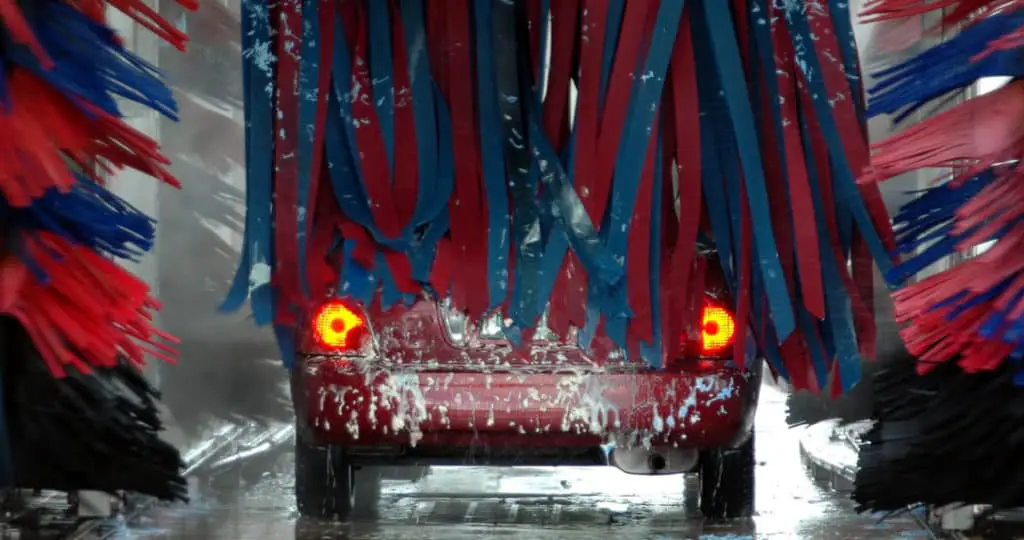- How to Clean Car Carpets Quickly (Without An Extractor) - July 10, 2024
- Can You Touch Up Clear Coat On A Car? Yes and No (Here’s Why) - November 25, 2023
- How To Wax A Car By Hand (For Beginners) - November 14, 2023
Last Updated on December 8, 2024 by Nate Schnell
Ceramic car coatings have completely transformed the way we care for and protect our cars. Ceramic coatings and waxes, used to be a professional service, are now sold as professional quality DIY products. Ceramic wax also sounds appealing because you can have the protection, shine, and hydrophobic properties of a ceramic coating while still getting the convenience of waxing.
This article will cover every step, from preparing to applying to maintaining, if you’ve been wondering whether to give ceramic wax a try on your vehicle.
What Makes Ceramic Wax Special?
Ceramic wax blends traditional car wax with ceramic compounds, creating a product that provides better durability and protection. Traditional waxes offer temporary shine and a limited barrier against contaminants, but ceramic wax goes further. Its ceramic components bond with the paint, forming a harder, more resilient layer of protection that can last months.
Benefits of ceramic wax include:
- Long-lasting protection: Lasts much longer than traditional wax, often up to 12 months.
- Hydrophobic properties: Repels water, making rain and grime bead up and roll off.
- UV resistance: Shields paint from harmful sun exposure, preventing fading and oxidation.
- Enhanced gloss: Leaves your car with a deep, radiant shine.
- Cost-effectiveness: DIY ceramic wax is more affordable than professional ceramic coatings while offering comparable benefits.
The Importance of Preparation
Achieving optimal results from ceramic wax requires a well-prepared surface. Proper preparation ensures that the wax bonds effectively and enhances the overall appearance of your car. Skipping this step can lead to streaks, uneven application, or contaminants being sealed under the wax.
How to Prepare Your Car for Ceramic Wax
- Wash and Dry
Start with a thorough wash to remove dirt, grime, and road debris. Use a pH-balanced car shampoo and rinse from top to bottom. Dry the car completely using a microfiber towel or a leaf blower to avoid water spots. - Remove Embedded Contaminants
Run your hand over the car’s surface inside a plastic bag. If it feels rough, there are contaminants like tar or industrial fallout stuck to the paint. Use a synthetic detailing clay or clay bar to remove these embedded particles, leaving the surface smooth. - Correct Paint Imperfections
If your car has minor scratches or swirl marks, address them before waxing. A polish-and-wax product, such as a hybrid ceramic polish, can handle light imperfections. For deeper scratches, consider a dedicated scratch repair product before moving forward.
Step-by-Step Guide to Applying Ceramic Wax
Once your car is clean and prepared, it’s time to apply the ceramic wax. While the process is straightforward, attention to detail will make the difference between a good finish and a great one.
1. Work in Proper Conditions
Find a shaded area or work in a garage to prevent the wax from drying too quickly. Proper lighting is also essential to spot any missed spots or uneven application.
2. Apply the Ceramic Wax
Using a foam applicator pad, apply a small amount of ceramic wax to the pad. Less is more—using too much product can make buffing more difficult.
3. Work in Small Sections
Divide the car into manageable sections, such as working on one door, hood, or fender at a time. This ensures you don’t miss any areas and allows for consistent application.
4. Use Circular Motions
Apply the wax in small, circular motions to ensure even coverage. This technique also helps the wax bond effectively with the paint.
5. Allow to Haze
Let the wax sit on the surface for a few minutes, or as directed by the product instructions, until it forms a hazy layer.
6. Buff Off the Wax
Use a clean, dry microfiber towel to buff off the hazed wax. Work gently but thoroughly, ensuring no residue is left behind.
7. Inspect Your Work
Examine the car under good lighting to check for missed spots or areas where the wax wasn’t buffed properly. Touch up as needed.
8. Allow to Cure
Many ceramic waxes require a curing period, typically 24 hours, during which the car should not be exposed to water. This step allows the ceramic components to bond fully with the paint.
Post-Application Care
To maintain the protective benefits and shine of ceramic wax, follow these care tips:
- Wash regularly: Clean your car every two weeks using a gentle, pH-balanced car shampoo.
- Avoid harsh chemicals: Steer clear of abrasive cleaners or detergents that can degrade the wax.
- Reapply as needed: While ceramic wax can last up to 12 months, reapplying every six months ensures optimal protection.
Common Mistakes to Avoid
Even with a user-friendly product, mistakes can undermine your results. Be mindful of these pitfalls:
- Applying in direct sunlight: This can cause the wax to dry unevenly, leading to streaks.
- Skipping preparation: Failing to remove dirt or contaminants before waxing will lock imperfections under the wax layer.
- Using too much product: A small amount of wax goes a long way—overapplication can waste product and make buffing harder.
Comparisons with Other Products
When choosing how to protect your car’s paint, it’s helpful to understand the differences between ceramic wax, traditional wax, and other options:
- Traditional wax: Offers shine and temporary protection but lacks the durability of ceramic wax.
- Paint sealants: Provide longer protection than traditional wax but may not deliver the same level of gloss.
- Ceramic coatings: A more permanent solution offering superior protection but requires professional application and a higher cost.
How Frequently Should Ceramic Wax Be Reapplied?
The longevity of ceramic wax depends on the product used, environmental conditions, and maintenance habits. Most ceramic waxes promise protection for 6–12 months, but environmental factors like harsh sunlight, frequent rain, or road salt can shorten this timeframe. For consistent protection and shine, reapply every six months.
Final Thoughts
Applying ceramic wax is an accessible, cost-effective way to protect your car’s paint and keep it looking its best. By following proper preparation, application, and maintenance techniques, you can achieve professional-quality results at home. Ceramic wax combines the best of traditional waxing with the advanced protection of ceramic coatings, making it an ideal choice for DIY enthusiasts.
With consistent care and periodic reapplication, your car will stay protected, shiny, and ready to turn heads for years to come. Happy detailing!



